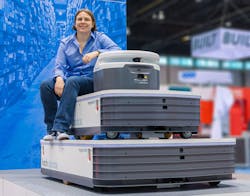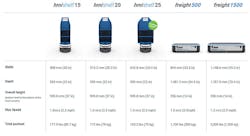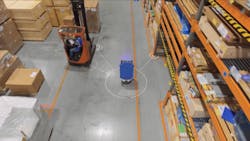During Melonee Wise's time at the influential Silicon Valley robotics research lab Willow Garage, she worked on self-driving cars and boats, and personal robots for hospitality and healthcare. After leaving, Wise pursued the one vertical that would have the most immediate impact: warehouse and distribution robots.
On the surface, accident-preventing autonomous cars and robo-nurses to help grandma out of bed certainly sound like they'd be more helpful to society. But a deeper dive shows Wise's choice was absolutely the, *ahem*, wise choice.
The global logistics industry is valued at $5 trillion, and customer expectations have never been higher due to ecommerce envelope-pushers like Amazon Prime's two day delivery.
"The industry is being pushed really hard to deliver on a faster and faster time contract between them and the customer," Wise says. "Now people want their goods in hours; ten years ago it was maybe a week."
To exacerbate matters, there's not enough people who want the usually low-paying material handling jobs. A 2015 survey done by CSCMP and Capgemini Consulting indicates nearly four out of five third-party logistics providers were unprepared for the impending labor shortage.
"You've got an industry that needs to hire more people and needs to be more efficient, and needs to deliver on these requirements for customers, and yet the resources aren't available," Wise says.
Her solution was to found and become the CEO of the San Jose-based Fetch Robotics, and consequently, create AMRs (Autonomous Mobile Robots) that roll along on the bleeding edge of material handling technology.
The Freight line comes in several models, including the Freight 500 and 1500, named for their payload capacity (in kg), as well as the three-tiered 15, 20 and 25 HMIshelf(coming soon), which are named for their width (in inches). The various models can do anything from haul boxes in plastic pallets around a busy warehouse floor, track inventory with an RFID scanner. The Freight models can combine with a collaborative robot named Fetch, "armed" with seven degrees of freedom and interchangeable fingertips, for research and development projects.
The most obvious advantage are unlike automated guided vehicles (AGVs), AMRs don't need to alter the environment with magnetic tape or reflectors to create a fixed route for the one-track minded machines.
"If an AGV is driving down a path, and something is in its way, the robot will stop and wait right there until the object is moved," Wise says. "And it will wait forever. In the case of an AMR, the robot doesn't have a specific path. You create the suggested path, and will go around or go back and take another path if something is in its way."
Fetch's AMRs take as little as eight hours to install, and learning the path initially takes only a joystick and muscle memory from playing MarioKart, or for those old timers who once played outside, an R/C car. During this time, the Freight's will map the facility to get a literal lay of the land.
The controller will at this time also mark keep-out areas, speed zones, preferred paths, and destinations for the robots, Fetch says.
Fetch has mapped a 2 million-ft² facility before, Wise says.
The sensors to allow this include two IMUs (intertial measurement units) to gather rotation velocity and forward acceleration, a 25-m SICK laser scanner, and 3D camera for dynamic obstacle avoidance, including forklifts. Future models are expected to have two Intel RealSense cameras to increase awareness.
Wise says Fetch has the fastest deployment time. Competitors AMRs may take six to fifteen weeks, and AGVs can take several weeks. Fetch also doesn't require additional infrastructure like separate Wi-Fi.
AGVs also have the disadvantage of inflexibility when it comes to changing workflows. If a manufacturer or warehouse wants to change its configuration, the route for the AGV must be changed all over again. With the company's cloud-based software platform FetchCore, changing routes is a quick drag-and-drop process on the app, and simple enough to be completed by operators.
Last December, Fetch raised $25 million in Series B funding to continue its growth and expand into even more applications.
"The warehouse and logistics automation market is estimated at over $40 billion today, and is poised to double over the next five years," said Brian Nugent, Founding General Partner at Sway Ventures. "Our investment in Fetch complements and extends our portfolio of exceptional leaders who are transforming the global supply chain."
As the supply chain changes, Wise advises to explore all material handling options, not just the fancy, high tech ones.
"Some problems are just solved better by simpler more cost effective robots," says Wise, adding that AGVs cost less and may offer higher capacities.
In other words:
Other times, a combination of an AMR and an Automated Storage and Retrieval (ASR) system could work best, she offers.
"Most automation equipment are not one size fits all," she says. "Fetch is one part of a very large automation story. We want to play a lot of parts in that story, but we can't solve all of it by ourselves."
As robots are an ever increasing presence in the supply chain, Fetch, which offers an ROI in three to nine months and handles half of the material handling for customer RK Logistics, it does seem to be carrying quite a load.
One last thing: These AMRs may be eliminating low-level, unfilled warehouse jobs, Fetch is hiring. Check out the current jobs here: https://www.themuse.com/jobs/c-fetchrobotics-jobs














